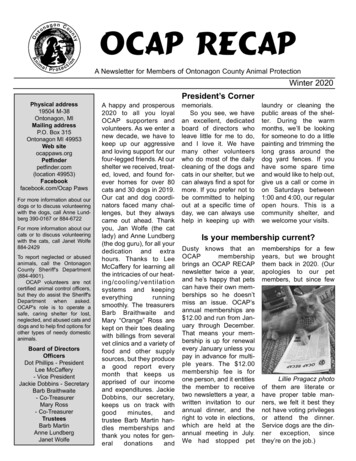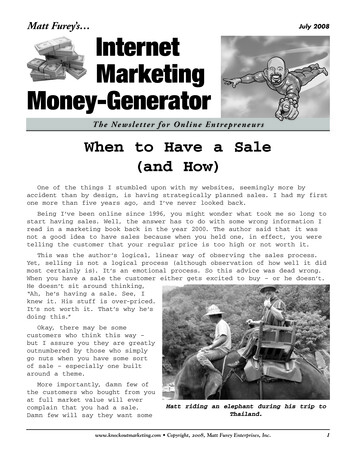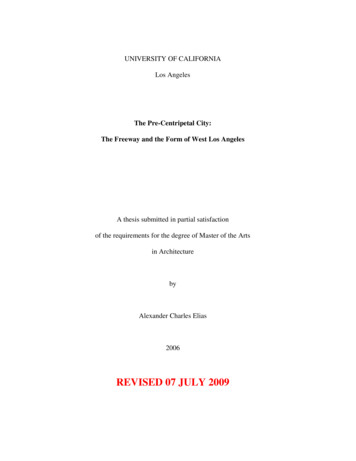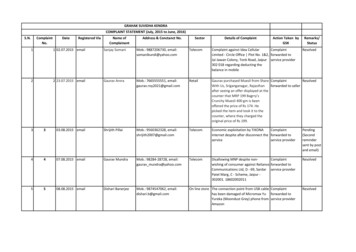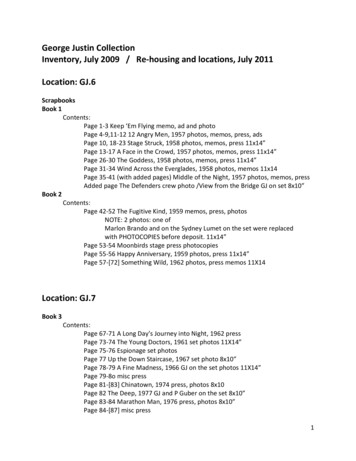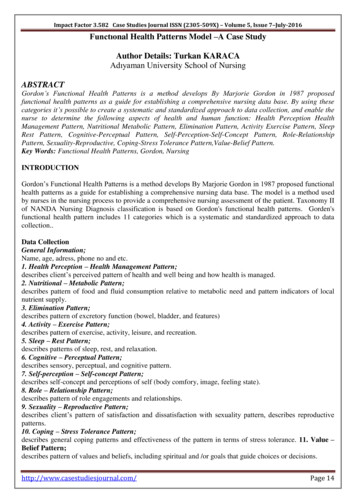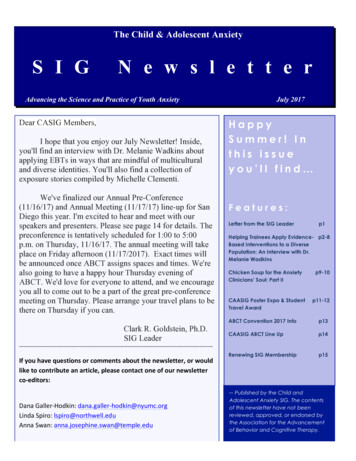
Transcription
The Child & Adolescent AnxietyS I GN e w s l e t t e rAdvancing the Science and Practice of Youth AnxietyDear CASIG Members,I hope that you enjoy our July Newsletter! Inside,you'll find an interview with Dr. Melanie Wadkins aboutapplying EBTs in ways that are mindful of multiculturaland diverse identities. You'll also find a collection ofexposure stories compiled by Michelle Clementi.We've finalized our Annual Pre-Conference(11/16/17) and Annual Meeting (11/17/17) line-up for SanDiego this year. I'm excited to hear and meet with ourspeakers and presenters. Please see page 14 for details. Thepreconference is tentatively scheduled for 1:00 to 5:00p.m. on Thursday, 11/16/17. The annual meeting will takeplace on Friday afternoon (11/17/2017). Exact times willbe announced once ABCT assigns spaces and times. We'realso going to have a happy hour Thursday evening ofABCT. We'd love for everyone to attend, and we encourageyou all to come out to be a part of the great pre-conferencemeeting on Thursday. Please arrange your travel plans to bethere on Thursday if you can.Clark R. Goldstein, Ph.D.SIG LeaderJuly 2017HappySummer! Inthis issueyou’ll find Features:Letter from the SIG Leaderp1Helping Trainees Apply Evidence- p2-8Based Interventions to a DiversePopulation: An Interview with Dr.Melanie WadkinsChicken Soup for the AnxietyClinicians’ Soul: Part IICAASIG Poster Expo & StudentTravel Awardp9-10p11-12ABCT Convention 2017 Infop13CAASIG ABCT Line Upp14Renewing SIG -------------If you have questions or comments about the newsletter, or wouldlike to contribute an article, please contact one of our newsletterco-editors:-- Published by the Child andDana Galler-Hodkin: dana.galler-hodkin@nyumc.orgLinda Spiro: lspiro@northwell.eduAnna Swan: anna.josephine.swan@temple.eduAdolescent Anxiety SIG. The contentsof this newsletter have not beenreviewed, approved, or endorsed bythe Association for the Advancementof Behavior and Cognitive Therapy.
Child and Adolescent Anxiety SIG NewsletterJuly 2017 p. 2Helping Clinicians-in-Training Apply Evidence-Based Interventionsfor Youth in a Way that is Mindful of Issues Related to MulticulturalIdentity and Diversity: An Interview with Melanie Wadkins, Ph.D.Interview Conducted by Rachel Terry, Psy.D.Melanie Wadkins, Ph.D. is an Associate Professor of Psychology at YeshivaUniversity’s Ferkauf Graduate School of Psychology in the CombinedClinical Child Psychology and School Psychology Psy.D. Program. Dr.Wadkins has focused her career on both researching and treating youthanxiety disorders. In addition to leading the Ferkauf Anxiety Research(FAR) Lab, Dr. Wadkins is one of the clinical instructors of the CBTPracticum for Youth at the graduate school’s clinic, The Parnes Clinic. Dr.Wadkins helped establish the CBT Practicum for Youth at The Parnes Clinicapproximately five years ago, working in close collaboration with hercolleagues Greta Doctoroff, Ph.D. and Sarah Kate Bearman, Ph.D.Together, they established an extensive program to help students receivedidactic and clinical training in evidence-based interventions (EBIs) foryouth.The Parnes Clinic currently stands as one of the largest university-basedclinics staffed by graduate students in the country, and one of a handful ofclinics in the Bronx that provides sliding scale CBT services for youth.Clients at the clinic come from a diverse range of backgrounds with regardto socioeconomic status, race, ethnicity, religion, gender identity, sexualidentity, and family composition. Given the theme of ABCT’s upcomingconvention, Applying CBT in Diverse Contexts, I sat down with Dr. Wadkinsto learn more about her experiences training doctoral students to utilizeEBIs for youth anxiety disorders—and EBIs in general—in a way that ismindful of multicultural identity and diversity.Q: In your experience, what are some of the challenges that come alongwith supervising students as they first learn to apply EBIs for youthanxiety disorders, and EBIs in general?
Child and Adolescent Anxiety SIG NewsletterJuly 2017 p. 3I think that one of the most important parts of what I do when I get newstudents is to empower them and help them feel confident. Often timesstudents get their first case and feel like they don’t know what to do. I tellthem, “You know exactly what to do. You just haven’t done it yet.” Iprovide scaffolding and ask them to tell me what they would do, using theirknowledge of evidence-based interventions. You know what to do whensomeone comes in with a phobia—what is that? Right, it’s exposuretherapy—you know what it is, so now let’s talk about how to do it. So that’sreally the first hurdle, building confidence. The students have a strongacademic background in EBIs, so it’s important to help them go into thesessions with the confidence of, “I know what to do. I’m figuring out how todo it. It’s okay if I don’t know how to do it immediately, because I’m tryingdifferent things.” So I really love taking people from here’s the manual,what you do, to now let’s figure out how you do it using your resources andbeing creative to tailor it to each specific client.Q: How do you help students learn to apply CBT in a way that accountsfor each client’s identity, background, and personal values?At the beginning of every year in the practicum, we have all of our studentsread the article Flexibility within Fidelity (Hamilton, Kendall, Gosch, Furr,& Sood, 2008)*. It’s our starting point for the practicum each year andencapsulates the idea that we want students to provide good CBT withfidelity to the treatments as they are intended to be delivered, and at thesame time we also know that flexibility is important.We’re dealing with a very unique population in the Bronx—we havediversity of every kind you can think of. Many students in the practicum*Hamilton, J. D., Kendall, P. C., Gosch, E., Furr, J. M., & Sood, E. (2008). Flexibility withinfidelity. Journal of the American Academy of Child & Adolescent Psychiatry, 47(9), 987-993.
Child and Adolescent Anxiety SIG NewsletterJuly 2017 p. 4come into contact with clients they haven’t had experience with during otherclinical training experiences, and often times the practicum is one of theirfirst experiences providing therapy. So many of our students, really for thefirst time, are starting to encounter clients one-on-one who might be verydifferent from them. We also have experiences where students encounterclients who are very much like them. And that has been interesting to watchtoo because they almost have to work harder to not make assumptions abouttheir clients that might be easy to make.In the Fall semester we focus on orienting our students to using CBT withchildren and families. By the Spring semester we ask that when studentsconduct case presentations they also find an article to present to the classabout something specific related to the client’s identity. We really encouragestudents to highlight an aspect of multicultural identity that seems to beimpacting the treatment, so the students are specifically searching in theliterature for how to tailor treatment. A great example from this semester is astudent who is working with a young man with an incarcerated parent andfound a great article on working with children of incarcerated parents. Ilearned so much reading that article—it was not something I was familiarwith in terms of the research base. I feel like I’m constantly learning fromour students. Students go out and find important articles that really help usexamine where there is evidence and where there isn’t. Then, we can reallycritique the research base and see where the holes are right now It’s anaddition to our training that encourages them to be independent learners andexperts, to come in and present not just the work they’re doing in the case,but also how it connects to the literature. And it’s not as simple as you wantto believe, people are complex, but I love having the element of, okay sowe’re all very well versed in the treatment for anxiety, how can we nowcustomize it in an idiographic way for each patient.Q: What are some ways therapists in training can address issues related tomulticultural identity during initial meetings with clients?
Child and Adolescent Anxiety SIG NewsletterJuly 2017 p. 5This is something I, as a supervisor and instructor, have learned to pay moreattention to: the idea of just asking. It seems so obvious and simple, howeverthe idea is really a bit controversial to some people because in our societywe’re not always open to asking questions about identity. I think we get a lotof training as clinicians on how to ask hard questions about sensitive topics,such as suicide and drug use, but there hasn’t always been a focus on how toask people about how they identify and how aspects of their identity mightbe impacting their day-to-day life, mental health, and well-being. Duringstudent intake presentations I try to ask a lot of questions about their clientsto see where the students’ “I don’t knows” are. Instead of students feelingsheepish about the “I don’t knows” related to their clients, which is not whatI want, I take the opportunity to help them figure out how to ask importantquestions about identity. I want my students to eventually say, “Okay this iswhat I have to start asking every time I do an intake because this isimportant information.” It’s really important just to get comfortable withdeveloping your style of how you’re going to gather this type of information.I think that a stance of genuine curiosity, cultural humility, and not beingashamed to say, “I don’t know about this, but I want to know about it” canbe helpful. It can also help shift some of that power dynamic in the therapyrelationship back to the client.Q: How do you help students integrate issues of multicultural identity intocase conceptualization and treatment planning?In the practicum we spend a lot of time on case conceptualization becauseit’s so important in terms of building the roadmap for treatment. We spend alot of time working on what a case conceptualization should look like andemphasizing that it’s a living document that will constantly change duringtreatment. Through progress monitoring, close supervision, and groupconsultation we’re constantly updating what we’re thinking about our clientsand our understanding of what’s contributing to their issues. So as thingscome up, as you learn more about the client’s identity, you’re alwaysthinking: how is this new information changing the way we see what led totheir problems and what’s keeping their problems going right now? Or their
Child and Adolescent Anxiety SIG NewsletterJuly 2017 p. 6identity is changing in some way and we think, okay, how does this updatewhat we know about the client?I love to keep talking to students about their case conceptualizations as wego through treatment. Each time a student does a case presentation over thecourse of the year we ask them to present their case conceptualization. Youcan see that sometimes students think, “Here’s the straightforward thing Ialready told you before: it was on my intake report and I just have to spit itback out to you.” And I try to help them see, “Oh wait, it should be differentthis time.” There should be something new in the case conceptualization,because you’ve worked with the client for three more months. After threemonths, it would be unusual if your conceptualization hadn’t changed or youhad hadn’t learned something that at least highlights a current maintainingfactor. Maybe you had a good handle on etiology and how it started, but nowyou’ve added to what’s maintaining the problem.Q: In terms of tailoring the treatments to each individual client, how doyou encourage the students you’re working with to connect to thecommunities of their clients?As much as possible, we encourage students to be out in the relevantenvironments with their clients. Our students have a lot of contact withschools, and we really encourage that. As part of our progress monitoring weget teacher reports, so that helps establish the relationships with schoolsfrom the beginning. Some teachers are more or less overwhelmed andaccessible than others, but it’s a really important part of our work. We wantour families to know that we will go and be out there for them.We do get some roadblocks. Being in New York City, the schools have verystrict rules about who is able to push in and help with services. We have acase right now where the student has been working very hard, and the schoolhas not been very open to letting us into that environment, so we’ve had to
Child and Adolescent Anxiety SIG NewsletterJuly 2017 p. 7adapt. The therapist goes to pick-up time after school, so she’s on schoolgrounds and it’s okay for her to be there and they do exposures in that way,instead of being able to come in during the school day. So I think we reallywork creatively to try to help clients generalize their skills to importantenvironments. We use our local community and neighborhood forexposures, using resources in the community.Q: In your experiences teaching and supervising students, have younoticed any challenges specific to helping marginalized or underservedindividuals with anxiety disorders?I think in general, in the neighborhoods where we draw most of our clients,kids are living in really stressful and dangerous situations. We get referralsfor kids who have been exposed to domestic violence or violence in theirneighborhood or building. So we have this population that’s been exposed toviolence, and we have referrals for kids who are experiencing post-traumaticstress, or have developed fears of going outside, being in certain places inthe neighborhood. We also then have protective parents who recognize thatthey’re raising their children in dangerous environments, or are havingdifficulty giving their kids independence that we might associate with aparticular developmental age or stage. So I think that we have to be verysensitive to those issues. If you really did see someone get shot at theneighborhood park, you are going to be very afraid of that park. And even ifit’s a very rarely occurring threat, it's not an impossible threat anymore. It’svery different than the child who has never experienced that kind of scenariobeing afraid of going to the park. Our population is exposed to stressful anddangerous living conditions, and we have the unique opportunity to workthat into our training with evidence-based interventions.Q: In your experiences as a clinical instructor, have you come across anyareas that you believe could benefit from additional clinical resourcesand/or research?
Child and Adolescent Anxiety SIG NewsletterJuly 2017 p. 8Most recently, because of the diverse population we work with in the Bronx,we often have families where the parents of the clients don’t speak English,and that can present a challenge for most of the traditional CBT materialsthat we have. While we can work with the child in English, we often have topull the parent portion of the therapy from other resources. We’ve had greatstudents and supervisors help us locate more of those resources, but it can bechallenging to find materials in other languages. For example, right nowwe’re working with one family where the mother is from a South Asiancountry and she speaks enough English to meet and work with the therapistwho is providing Parent Management Training. However, we would love tobe able to provide her with materials in her native language. So that’s onearea that can be challenging, and I now try to collect CBT-related resourcesin other languages.Related to that, I have been more mindful of collecting resources for parentsand children with limited cognitive abilities. For example, we have one casewhere the mother is very dedicated to her child and really soaking in a lot ofthe skills but doesn’t have the reading level or ability to use most of thehandouts that currently exist. Thankfully, great students and supervisors areadapting existing materials, but I would love to see evidence-based,validated protocols that are specifically written for people of differentcognitive abilities to get these skills. You can’t necessarily use childmaterials for a parent—it doesn’t feel right—so having parent materials thatare easier to digest would be ideal. Those are two practical gaps in whatwe’re doing that have been on my mind recently. That’s my currentmission—to help parents of diverse backgrounds become involved in theirchildren’s lives and treatment experiences. I’m sure someone is doing greatwork on this, but we need to get these materials that work for lots ofdifferent people more widely disseminated.
Child and Adolescent Anxiety SIG NewsletterJuly 2017 p. 9Chicken Soup for the Anxiety Clinician’s Soul: Part IIComplied by Michelle Clementi, M.A.1Following the success of the compilation of humorous and unusual exposurestories presented in the September 2016 SIG newsletter, we are providingPart II for your enjoyment. The following stories were submitted by realclinicians. Thank you to those who contributed stories highlighting what cansometimes be an amusing part of our jobs.A Medical Surprise“I was working with a patient who was very fearful of trying new foodsbecause he was afraid of having an allergic reaction and getting sick (despiteno history of allergies). We built a hierarchy that involved trying new foods,and went all around the city to different fruit carts, food trucks andrestaurants to do samplings. Mango was one of the fruits highest on hishierarchy. While doing the exposure to mango, we both enjoyed eating ittogether, and my patient was excited about tackling this task. Shortly aftereating it, my arms started getting blotchy, red, and itchy. I started to scratchmy arms (I tried to do it discretely). My patient noticed and asked me if Iwas doing it to ramp up his anxiety for the exposure. But I wasn't; it turnedout that I was having an allergic reaction to the mango! I decided to behonest with my patient about my experience (and couldn't really hide itbecause I was wearing short sleeves!). Fortunately, my patient handled itvery well. He got to see that even though I did have an allergic reaction, itwasn't catastrophic. It was actually a helpful experience for him to be able tosee an anxiety provoking situation being modeled calmly. We were able tolaugh about the experience together later.”The Bug Collector“I worked with a teenager who was terrified of the ‘stinkbugs’ that hadinvaded the area I was working in at that time. I had to get really good atcatching them in my apartment (where there were many) and transportingthem into the office for exposures. A lot of Ziploc baggies and disposableTupperware were used. Stinkbugs are actually quite stupid and slow, socatching them was not very difficult. Things got more challenging, however,
Child and Adolescent Anxiety SIG NewsletterJuly 2017 p. 10as we moved up the hierarchy from dead stinkbug to live stinkbugexposures, because I had to figure out how to keep them alive long enoughfor our sessions!”The Celebrity Guest“I was working with a teenage male patient struggling with OCD andperfectionism related to his appearance. With aspirations to be a model, hehad worries about whether he would be spotted by a celebrity when hewasn’t looking his best. We set up an exposure to walk around the city withour hair totally out of place. We both ‘messed up’ our hair, making it asmessy as it could possibly look, and set out together to walk through thedesigner shops near my office. After walking through several storestogether, I spotted my favorite TV personality—Savannah Guthrie from theToday show! I have always wanted to meet her, and I couldn’t hold myselfback. I yelled out, ‘Hi Savannah!’ and she waved and said hi to both me andmy patient. As we walked away, my patient and I walked away laughing atthe rid
The Parnes Clinic currently stands as one of the largest university-based clinics staffed by graduate students in the country, and one of a handful of clinics in the Bronx that provides sliding scale CBT services for youth. Clients at the clinic


